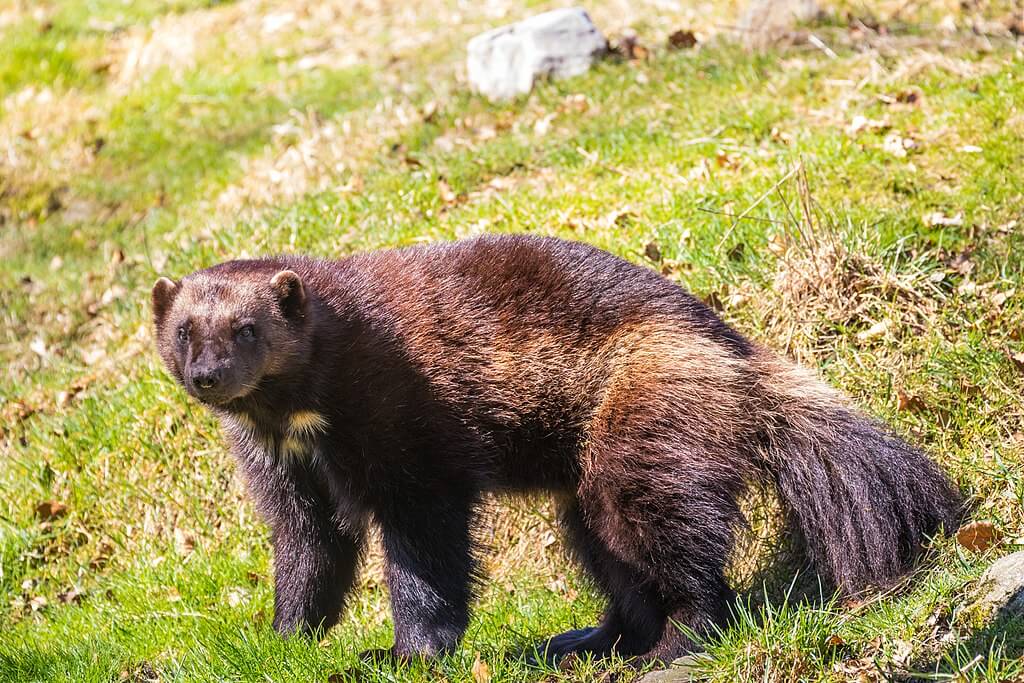Gluttony, Wisdom, and Wonder
By Megan Martinez
Broadcast 3.8 & 3.11.2023

It was a wolverine!!! Photo by Susanne Nilsson, CC-by-SA 2.0.
Listen:
I really wanted to see a wolverine. They seemed a unique type of amazing, starting with being solitary, fierce, and wide-ranging. They can crush bone with their sharp teeth and brawny jaws, and they’re opportunistic feeders, eating anything from roots and berries to birds, fish, and mammals. Although most weigh less than 40 pounds, they’ve been known to take down moose trapped in snow, and to fight wolves at carcasses. Furthermore, the wolverine is the largest member of the Mustelidae, or weasel, family, which ranks high amongst my favorite groups.
But I wasn’t thinking of any of this as I hiked through an open forest of lodgepole pine and Engelmann spruce in the Absaroka-Beartooth Wilderness a few Augusts ago. I was ahead of my husband when I spotted a bear standing in clear view, close by on the gentle slope that led away from the trail. I stopped and smiled as my brain tried to make sense of why the bear was so short and broad…and why were its legs and back darker than its tawny sides?
My jaw dropped when the synapses connected. It wasn’t a bear. It was a wolverine!
I am not prone to excessive exclamation points, but it was a wolverine!!!
We made eye contact, and then the wolverine strode purposefully up the slope and out of sight. I replayed the scene in my head and grinned.
Back at home, I looked up wolverines online. For habitat, they require large, isolated, roadless areas. They are supremely adapted to snow. Their enormous feet allow them to tread easily, and their long claws act as crampons on ice and help them to dig for buried carcasses. They give birth—usually to two to four young—in the winter. Their Latin name is Gulo gulo. Carl Linnaeus gave them this designation in 1758, to reflect their seemingly gluttonous behavior.
I was thrilled to have seen one. This connection with an animal I’m in awe of still lights me up. The experience provides food for thought, too…
I’ve tried to think of the right word for how these encounters with the earth’s marvels make me feel. And does the right word even make a difference? If “glutton” supposedly sums up wolverines, Carl Linnaeus believed that “wise” encapsulates humans, designating us Homo sapiens the same year that he named wolverines. But the delight I feel isn’t wisdom.
Maybe wisdom isn’t the best stand-alone descriptor for our species. In some ways, I’m not sure that we’re all that different from wolverines. Like us, wolverines are powerful. Like wolverines, humans are opportunistic. However, humans take more than we need. That seems like gluttony. Wolverines, on the other hand, do not…and even if that stems from instinct, the effect seems like wisdom.
We humans like to believe that our own actions resemble wisdom more than instinct. But sometimes feelings foster more wisdom than analysis. Every day we have the chance to interact with other life forms that, like us, have made it through billions of years of evolution and survival. Perhaps we should bask more in the glow of wonder these interactions can bring.
Focusing on that sense of wonder might be the ticket to a long and healthy future with our counterparts, whether furry, feathered, slimy, scaly, wise, timid, or fierce. Although we call ourselves Homo sapiens, I’m not so sure that we can hang our hats for a fair and bountiful future solely on the deeply cerebral trait of wisdom. So, we might benefit from a different descriptor. “Homo admirans”—man that admires or respects—now, that could get us somewhere.
Every week since 1991, Field Notes has inquired about Montana’s natural history. Field Notes are written by naturalists, students, and listeners about the puzzle-tree bark, eagle talons, woolly aphids, and giant puffballs of Western, Central and Southwestern Montana and aired weekly on Montana Public Radio.
Click here to read and listen to more Field Notes. Field Notes is available as a podcast! Subscribe on Apple Podcasts or wherever you listen to podcasts.
Interested in writing a Field Note? Contact Allison De Jong, Field Notes editor, at adejong [at] montananaturalist [dot] org or 406.327.0405.
Want to learn more about our programs as well as fun natural history facts and seasonal phenology? Sign up for our e-newsletter! You can also become a member and get discounts on our programs as well as free reciprocal admission to 300+ science centers in North America!












